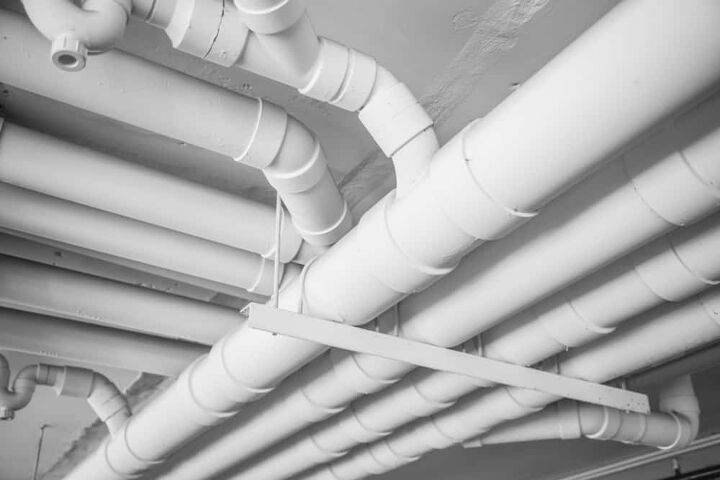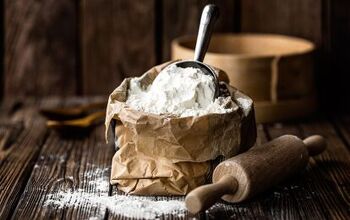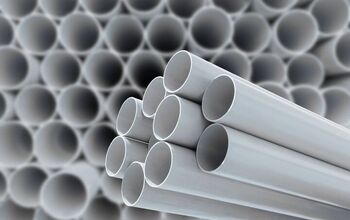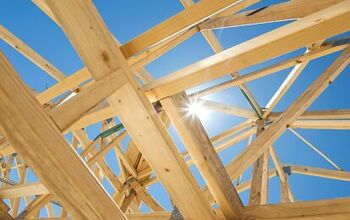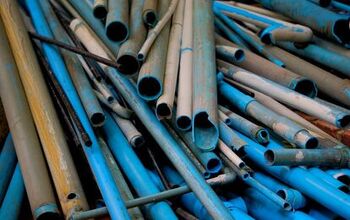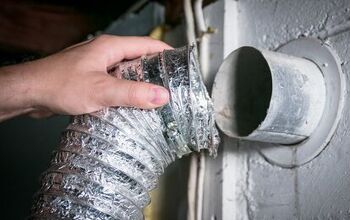How Much Weight Can PVC Pipe Hold (Find Out Now!)

When I first got introduced to PVC pipe, it was because friends of mine made faux swords for live-action role playing gear. Nowadays, I know PVC pipe is a staple of most plumbing endeavors, and to a point, can also be used in other projects. PVC is a pretty sturdy material, but every material will have its limits. So, what’s the deal with PVC pipe?
PVC pipe is remarkably strong when it comes to its tensile strength, but how much it can handle is going to depend on the size and thickness of the piping. Most PVC pipes will not be able to hold more than 28 pounds before they start to bend. Some pipes will also start to bend under their own weight if they are too long.
A good rule of thumb is that you should never try to use PVC pipe to hold large quantities of weight, especially if you don’t want them to be reinforced.
A Quick Guide On How Much Weight Your Pipe Can Hold
Physics means that your pipe will be able to hold less weight the longer and thinner it is. There are two main types of PVC pipe that you can get: self-deflecting and load-deflecting. When we are going to talk about the load that a pipe can bear, we are going to focus on load-deflecting pipes.
Self-deflecting pipes are generally going to start to bend underneath their own weight. How much they bend can vary greatly, but the truth is that the fact that they bend under their own weight suggests that they shouldn’t be used for load-bearing under any circumstances.
The Max Weight You Can Use On Load-Deflecting PVC Pipes
The chart below shows the stats on load-deflecting pipes, and how much weight they can handle on before they begin to bend. If your pipe’s horizontal length is over four feet in length, then you shouldn’t try to use it to bear loads, simply because longer pipes can become self-deflecting pipes.
| Horizontal Span Length (ft.) | 1/2″ Size | 3/4″ Size | 1″ Size | 1-1/4″ Size | 1-1/2″ Size | 2″ Size |
| 1′ | 18 lb. | 28 lb. | 40 lb. | 50 lb. | 58 lb. | 70 lb. |
| 2′ | 5 lb. | 10 lb. | 24 lb. | 35 lb. | 45 lb. | 55 lb. |
| 3′ | 3 lb. | 6 lb. | 11 lb. | 20 lb. | 30 lb. | 35 lb. |
| 4′ | 2 lb. | 3 lb. | 6 lb. | 11 lb. | 23 lb. | 28 lb. |
How Are These Load-Bearing Statistics Measured?
The way that these stats are measured out is simple. Scientists put the pipe between two chairs (or other things that hold it up). If it’s a self-deflecting PVC pipe, they measured how much of a bend the pipe had in the center. If it was load deflecting PVC pipe between the chairs, they would add weight until they noticed the PVC pipe bending in the middle. That would turn into the max weight they can bear.
If you want to calculate the vertical load of any of these load-bearing statistics, multiply the maximum load by 2.8. The vertical drop helps reinforce the strength of PVC immensely.
Will You Be Able To Support That Weight On The End Of The PVC Pipe?
Here’s something that you need to be aware of with PVC piping and the maximum weight it can bear: the weight suggested is supposed to be measured at the middle of a pipe. If you put that same amount of weight on the end of your pipe, you will not only have the pipe bend, but also probably break.
This is because of the physics behind load-bearing. When scientists calculate load-bearing, they are relying on the tensile strength of PVC holding up both sides evenly. If you have a load on one end of the pipe, there’s only tensile strength supporting one side of the load. This puts a greater strain on the entire system.
Is It Smart To Use PVC Pipe For Load-Bearing?
Yes and no. PVC pipe on its own can be pretty fragile and frail, despite its sturdy appearance. While it can be used to bear a small load reliably in many cases, the truth is that it’s not an ideal material for this. If you don’t have anything else on hand, you can usually use PVC as long as it’s reinforced and engineered with a strong support system.
How To Reinforce PVC Pipe For Better Load-Bearing
If you want to use your PVC pipe for load-bearing purposes, there are ways to do it. These tips below can help make sure your pipe won’t bend or break while it’s keeping loads up:
- Use it for vertical load-bearing. Horizontal load-bearing means that you’re working against gravity a lot more. That’s why horizontal load-bearing maximums are so much lower than vertical ones.
- If you need to go horizontal, add supports. Having support beams that are vertically propping up the PVC pipe will offer reinforcements and greatly improve the overall sturdiness of your piping.
- Heavy load bearing shouldn’t be attempted with PVC pipe. Do you want to try to put 350 pounds on a PVC pipe? While having reinforcements near the middle of your pipe can help, we strongly suggest that you check out metal options instead. Extremely heavy loads should not be attempted with PVC.
- Use Kevlar support ropes whenever you notice bending. Sometimes it’s not so much a matter of being able to bear extra weight, but rather, a need to keep the pipe from bending under its own weight. Kevlar support ropes can help hang your PVC from the ceiling without bends.
When Should You Worry?
Let’s say that there is something you’re trying to build (or have built) and you’re looking at how much weight your pipe is bearing. You started to notice a little sag. Sometimes, that doesn’t have to be a big issue. When you notice a droop that’s over an inch in depth, or you notice that the PVC pipe is starting to warp, that’s when you should get concerned.
Warping can happen for a wide range of different reasons, but it often means that the PVC pipe you’re dealing with is undergoing structural stress. With self-deflecting pipes, that’s normal. But if your pipe is short enough to be load-deflecting, it’s a problem. Adding some supports can help reduce the stress. However, if it’s a system that has lots of risk involved (i.e., channeling steam to a place) you might want to call a pro.
Related Questions
Is it safe to use PVC for water lines?
It actually depends on the temperature of the water. If you want to use PVC to steer cold water (or lukewarm water) from one place to another, it’s great. PVC is strong enough to be able to be used in many plumbing situations, which is why most sink P-traps are made from the stuff.However, if you want to channel hot water through the piping, PVC is off the table. Water that’s too hot can actually break down the chemicals that make PVC strong. This, in turn, can cause the pips to break down, get brittle, and eventually spring a leak. To prevent problems later on, use metal for hot water plumbing.
Does Gorilla Glue work on PVC pipes?
Yes, but it really depends on which type of Gorilla Glue you want to get. Not all of the glues made by the Gorilla Glue company work very well. If you want to use it on PVC, the best option is Gorilla Glue PVC Cement. This has a specially-designed formula that naturally bonds to the polymers in PVC.If you don’t have Gorilla Glue Cement on hand, then you can use any other type of PVC-specific cement glue to fasten your PVC piping. With that said, we totally get the brand loyalty.
Why is PVC bad to use?
A lot of studies are now suggesting that PVC piping isn’t safe to use, at least for those with chemical sensitivities. PVC contains chemicals like phthalates, cadmium, and organotins that can leech into the water and air of your home. While the overall consensus is that PVC’s impact on your home’s chemical levels is not very powerful, it’s still something to keep in mind.We don’t fully know what the long-term effects of PVC piping in a home can be. Clearly, it’s not super dangerous, but it’s still worrisome.
Related Guides

Ossiana Tepfenhart is an expert writer, focusing on interior design and general home tips. Writing is her life, and it's what she does best. Her interests include art and real estate investments.
More by Ossiana Tepfenhart



